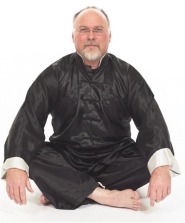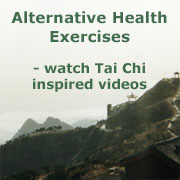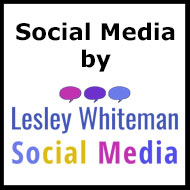Relax and move – everything follows from this:
Relax everything
Move from the centre
Everything moves together
Where there is a suitable environment such as an extended community of Tai Chi players to train with then it is certainly possible to work with the above principles and simply immerse in daily practice, self-learning and working with others. We should appreciate that in the land of its origin large groups gather every day to practice together for between two to eight hours in parks and in martial arts schools where this is both possible and convenient. Conversation about this practice is an integral part of the training, between teachers and students and among students sharing continuously so that the learning process becomes osmotic as understanding is passed around and everyone has the chance to work with many other players – use of language and close even intimate contact is fundamental to this. It is important to remember that human beings are a physical and social species.
Where you have daily access to a good teacher and/or a support group of others then of course you should take the opportunity wholeheartedly, using the experience to learn by trial and error and with the guidance of others from their own experience. However, for many of us elsewhere such an environment simply does not exist, nor does it fit the western culture or lifestyle, and so we may seek other more solitary approaches. I have sought to describe a way of augmenting training where immersive physical practice is not available or where time is limited, or perhaps where culturally what may be considered intimate contact is not acceptable. In this case then we can support our physical Tai Chi practice with frequent attention throughout the day in our normal tasks, in our walking around and in our thinking. It is important that this is closely involved with focused physical practice and not simply an intellectual exercise. The aim should always be integration – each physical or mental exercise being seen as part of the whole – like pieces of a jigsaw puzzle building up the full picture.
Working with a teacher and on your own loosen the body, then reconnect using tai chi exercises, forms, meditation, analogies, models and visualisations such as those derived from Taoism and Buddhism eg Yin/Yang, calming the mind. Some understanding of human anatomy, physiology and psychology would be helpful. Consider inputs from all other areas as well and incorporate what is useful.
Consider and explore the meanings and especially the physical expressions of the following in any order:
Observation
Attention
Connectedness
Sequential segmented movement
Posture
Balance
Self-alignment
Structure – and the concept of Tensegrity
Flow/fluidity
Softness
Fear – the meaning and utility
Finding the centre of oneself and of others
Practice
Being in the moment
Calming mind and body
Observe differences and similarities
Force and control
Working with your internal body feelings:
– eg muscles stretching, contracting, twisting and relaxing,
Learning your way around your own body
Where do bad feeling go
Consider your body usage
Passive elasticity
Opening and closing
Weight shifting
Sensitivity
Resilience and bounce
Sinking and turning as one
Smaller and smaller circles
Turning circles into straight lines
Balancing forces
Leverage – mechanical, psychological, temporal
Gravity – one degree, one dimension
Partner/opponent – 360 degree, three dimensions
Learn your way around other bodies
Immersive physical contact
Mapping personal space
Fear and trust
What is Chi
What is Tai Chi
What is Tai Chi Chuan
Martial – more complex, more softness, more speed, more power
Finding martial applications through the movement
Using the mind – conscious and unconscious
Movement, flow and intent
Moving without force
Observation and attention
Congruence in mind, body and emotions
Communication – physical and otherwise
The concept of chi
Is there an established path
Does tai chi exist
Which can lead on to considerations of:
Humanity
Reality
Consider the implications that languages are simply models to describe reality – whether French or Mathematics. With Tai Chi we are in a learning transition from reliance on eastern language models to ones that fit western, English language ones. The map is not the territory and of course the object remains the same regardless of the model we use or the perspective from which we describe it.
We should understand these labels are only individual parts of mental models or maps which represent the tip of an iceberg – we need to explore behind each of these labels to find what these words really mean and feel like to us internally and as individuals, to find more and to learn how they all fit together in the real world. Tai Chi allows us to do this by using the physical experience of our bodies in real world relationships. Regular frequent practice of Tai Chi forms and patterns allows us to explore all of these questions – do your intellectual thinking on the side lines, perhaps on a quiet walk so that your actual physical practice can be undertaken with a quiet mind and body.
In a very personal sense, each of us must travel the same path as our Tai Chi predecessors in creating an original synthesis of the many inputs, shared experiences and teachings available, so as to establish our own understanding and expression. The path is the same – how we walk it is up to us.





